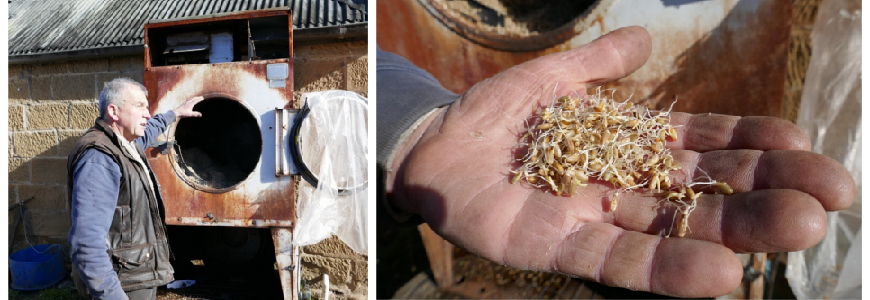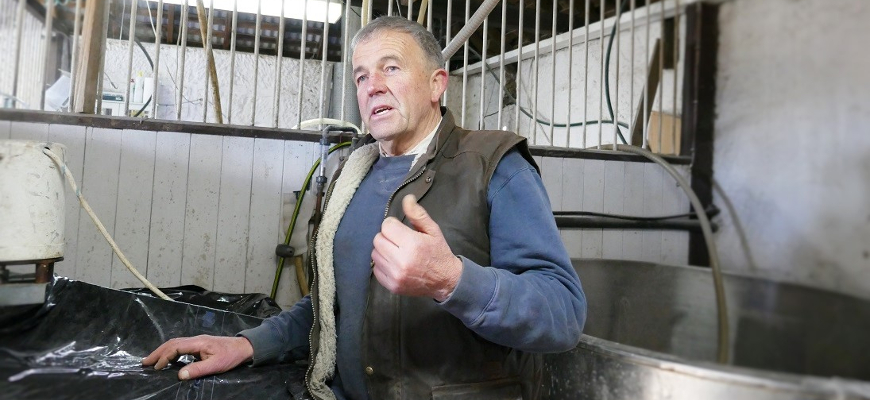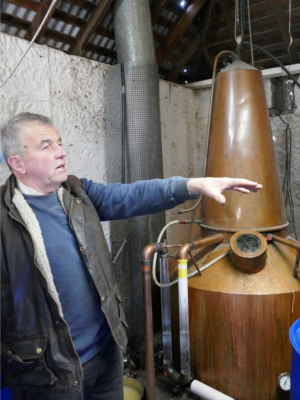Literally “hand-made,” green distillery(2/4) – Entrepreneurship at Tasmanian Whisky Distilleries REPORT #1: BELGROVE DISTILLERY

http://belgrovedistillery.com.au/
- A man on a bulldozer
- Literally “hand-made,” green distillery
- Let’s make it a hard but enjoyable work
- Magical taste of rye whisky
Chapter 2:Literally “hand-made,” green distillery
We chat for some time and I explained why I came all the way from Japan. Then the first thing he proudly showed to me was a uniquely-shaped device, standing beside the distillery. It looked like an old, rusty laundry machine or something. In fact it was his malting machine. In the vertically-set column were a lot of malts, stopped sprouting right before they start consuming the sugars inside themselves. Yes, that itself was a normal process for any whisky productions, but I had never seen a small and unique device like this for a malting process. He completes most of the malting process with this device, and when he wants to add some peaty flavor to the malts, he also applies peat fire here.

Then he invited me to inside the distillery. The house initially looked like a horse stable was in fact the distillery, and there on the left side of the room were a mill, a mash tun, and a small pot still. He explained how he works on the mash, including how he invites wild, indigenous yeasts and other bacterium e.g., lactic bacterium, to his mash. He does apply some commercially developed yeasts for fermentation, but most of the process were really hand-made. Standing beside him, I could feel he was taking care of the living organism, as opposed to handling a manufacturing process. I would proudly say, that the place was in fact a farmer’s workplace as I initially felt, not a whisky factory.

Then he took me to the pot still. It was – to be perfectly honest with you – a strange pot still which I had never seen before. There was no line-arm on top of it. You know, a line-arm is a sort of a symbol of a pot still, and we all talk about how the shapes of the line-arm affect the fragrance and taste of the final products. But it was not there… I was puzzled, but I soon realized there was a tiny pipe coming out of the body of the pot still and was connected to the barrel beside the still. That was in a sense the end of the line arm. According to Peter, that seemingly straight-head pot still had a double-surface structure inside, and the distilled liquid once go up inside the still and come down the second layer surface internally, and then the spirit flows outside through the tiny pipe I just saw. What a creative way to distill the wash!

Not only that, the heating fire comes from the bio-diesel he produced from discarded frying oil obtained from the roadhouse nearby. He also adds almost toxic alcoholic substance that comes out at the beginning of the distillation to the fuel. He does middle-cut the heads and tails, but he reuses them to the next distillation process. The cooling water comes from his dam, and the waste water is either recycled or used for irrigation, including the next rye crop. Brewing and diluting water is harvested from the roofs of farm sheds.
When I asked what was his principle or philosophy of whisky production, he immediately replied by saying, “it’s sustainability.” Building a sustainable eco-system as the whole distillery is guiding this farmer-turned whisky producer. He also hinted that for sure he would want to develop the distillery further, but he would not do so at the cost of his green philosophy. On his website, expressions like “closed loop” “small carbon footprint” “green” “farm based” “value adding” “craft” “low food miles” are quite visible, showing his true commitment to his philosophy.



